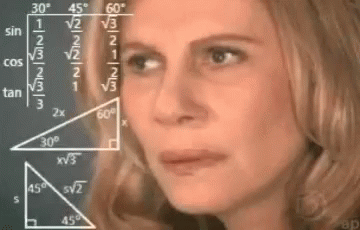We are coming up on the last month of summer school, and I know some of you have been wary of some of our classes...math included! Well, I'm here to assuage those fears: if you've ever knit, or crochet, or cross stitched, or done any weaving, guess what? You're already doing math!
record scratch
Wait, what? Yeah, it's true! Maybe it's not the complicated equations like whatever is in the graphic above, but it's most definitely math. Any time you've done a pattern repeat in the round, for example, that's math right there. Say you have an 11-stitch repeat that goes around your cowl pattern 17 times...that's 187 stitches every single round! For a 120 round cowl that's 22,440 stitches! How many stitches do you think that you've done in your life? In the hundreds of thousands? The millions?
And, have you ever whipped up a quick hat for someone? Lots of crocheters that we know don't usually follow a pattern - they know off the top of their heads how to make a perfect circle big enough to turn into a hat! That, my friends, is math!
Another aspect of math that trips up beginners to our crafts is in the form of charts. You'll find lots of patterns out there that are only charted, with limited written directions, and that can be really, really intimidating. Why does my hobby have graph paper? How do you read a chart? What does it all mean???
The good news is, if you're following a chart, then all the complicated math has been figured out for you! In crocheting, the only thing you need to know is where to start, and you can figure that out by looking for the starting chain stitches, which are usually shown with a little black arrow. The starting point will be different based on what kind of pattern you have: is it worked flat, or in the round. Our friends at DMC have put together this handy chart to help explain it all:

This heart has you start at the bottom with three chains, and then turn and put three half-double crochets in the first chain you made. Then you work up back and forth in the heart shape, and add a border around when finished. You read this chart left to right, from the starting point. Crochet charts are extra impressive because they let you communicate beyond terminology barriers -- you don't have to worry if the pattern you have is using British or American terms.
Once you get the hang of it, reading charts can unlock all sorts of complex patterning!!
Knitting charts are usually on a grid, and the way you read them also depends on the kind of pattern you have. It is very common to see color work and lace patterns charted out, because that makes it much easier to follow! Here's a quick color work pattern to preview:
This chart is set up to be worked in the round. You can tell because the numbering for the rows is all on the right side of the chart, but any pattern in the round will also tell you this in the written instructions! For stranded color work like this, all you have to do is knit with the alternating colors when the chart indicates. All of these are knit stitches, which are indicated by plain boxes.
If a chart is for a pattern that's worked back and forth, the odd numbers will be on the right side, and the even numbers will be on the left side of the chart. This helps remind you to read it right to left on the right side, and left to right on the wrong side. It seems complicated to write out, which is why charts are so handy!
We designed the chart above using an extremely awesome (and free!) website, Stitch Fiddle! It's not just for knitting, it's for all sorts of crafts! You can design any chart for yourself, or use it to work out complex written instructions if you're a more visual person. Our resident expert Amy says this is a great tool to figure out how to decrease in pattern, if you're ever given those instructions.
Of course, you don't need to make an account or use a custom website to make your own charts. You can draw them out by hand on graph paper, or even use Excel or Google Sheets to DIY it!
Do you like to knit with charts? What about crochet? Have you ever written your own chart, or designed your own garments? All this requires your math skills! Tell us below in the comments!














